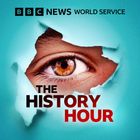
The History Hour
Oct 18, 2024
We hear about the Sunflower Movement in Taiwan in 2014. Brian Hioe, an activist who occupied Parliament in Taipei, recalls the events.
We hear from Nino Zuriashvili, one of the protesters at the Rose Revolution in Georgia in 2003. And Prof Kasia Boddy, author of Blooming Flowers: A Seasonal History of Plants and People explains how flowers have been used as symbols in political history.
Plus, the Afghan refugee who fled as a 15 year old. Waheed Arian, a doctor and former Afghan refugee describes his perilous journey.
We look at the Yellow Fleet of ships, which were stranded in the Suez Canal for eight years. Phil Saul, who looked after the engineers and officers on board the MS Melampus and MS Agapenor in the Suez Canal, recounts his experiences.
Finally, the story of the British afro hair care institution Dyke and Dryden. We hear from Rudi Page, the former marketing manager for Dyke and Dryden's afro hair products.
Presenter: Max Pearson
(Photo: An activist taking part in the Sunflower Movement in Taipei on 21 March 2014. Credit: Mandy Cheng/AFP)

